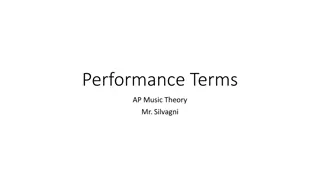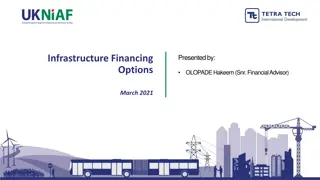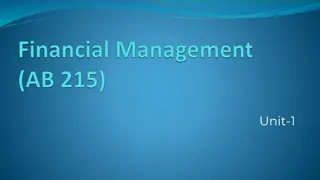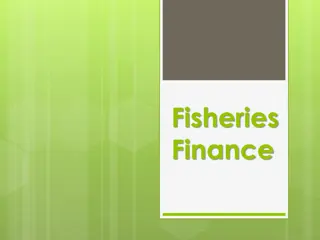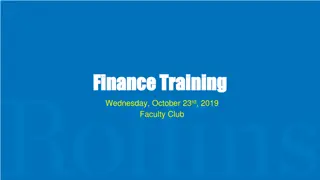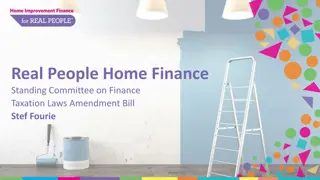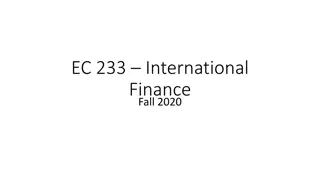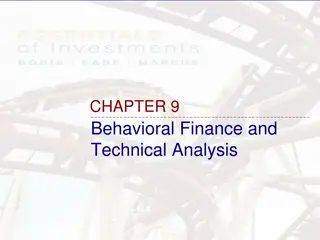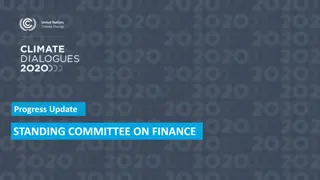Understanding Education Finance: Key Concepts and Terms
This information provides essential insights into education finance, covering topics such as constitution principles, budgeting, pupil accounting, general and special education, revenue programs, and where to find more information. It explains basic terms like revenue, levy, aid, adjusted net tax capacity, fiscal year, and categorical aid that are crucial for understanding the financial mechanisms in school districts. The details offer a comprehensive overview of the financial aspects related to education.
Download Presentation

Please find below an Image/Link to download the presentation.
The content on the website is provided AS IS for your information and personal use only. It may not be sold, licensed, or shared on other websites without obtaining consent from the author. Download presentation by click this link. If you encounter any issues during the download, it is possible that the publisher has removed the file from their server.
E N D
Presentation Transcript
Education Finance I: Constitution & Basic Terms II: Education Budget & Shifts III: Pupil Accounting IV: General Education & Referendum V: Special Education VI: Education Policy Programs VII: Other Revenue Programs VIII: Where to Get More Information Eric L. Nauman Fiscal Analyst 296-5539 Shelby McQuay Research Analyst 296-5259 Ann Marie Butler Yunker Counsel 296-5301 9/18/2024
Section I: Constitution & Basic Terms The stability of a republican form of government depending mainly upon the intelligence of the people, it is the duty of the legislature to establish a general and uniform system of public schools. The legislature shall make such provisions by taxation or otherwise as will secure a thorough and efficient system of public schools throughout the state. -- MN State Constitution, Article 13, section 1 2 9/18/2024
Basic Terms Revenue Funds available for school districts to spend Levy Revenue raised from taxation on property in a school district Aid Aid provided by state legislature to school districts Rule of Thumb REVENUE = AID + LEVY 3 9/18/2024
Basic Terms ANTC Adjusted Net Tax Capacity = The tax base used in many K-12 formulas to measure the relative wealth of property in each district. RMKV Referendum Market Value = The market value of all taxable property in a district excluding seasonal recreation and agricultural lands. Allowance A statutorily determined number that when multiplied by the number of pupils generates a revenue amount for districts. Equalization The process of reducing the impact of property wealth to generate revenue for school districts by appropriating state aid. State aid is appropriated in higher amounts for districts with relatively less property wealth. Equalizing Factor A statutorily determined amount of tax capacity per pupil that determines the amount of aid and levy in a given district. Districts with tax base above the equalizing factor receive no aid. 4 9/18/2024
Basic Terms Fiscal Year A 12 month budgeting period. For school finance & the state of MN, a fiscal year begins July 1 and ends June 30. School year 2010-11 is the same as FY 2011. Free and Reduced Lunch A measurement of family income that is used to determine eligibility for certain education programs including the free and reduced price school meal program and compensatory revenue Aid Entitlement 100% of the state aid a district or a charter school is eligible to receive in a given fiscal year. Aid may actually be paid in a separate fiscal year Categorical Aid Funds paid to a school district for a designated purpose. These funds may not be used for purposes that are not specified in law. Appropriation The amount of state aid that the legislature pays to districts and charter schools in a given year. In some cases, the appropriation consists of a portion of an aid entitlement from the current fiscal year and a clean-up payment from an aid entitlement from the prior fiscal year. 5 9/18/2024
Aid/Levy Split Policy The higher a district s property value, the more revenue is raised through local levy For a given amount of revenue the property poor district will receive a greater percentage of state aid/the property wealthy district will receive lesser amounts of state aid Example: 1000 900 800 Rev Value Per Pupil 700 600 State Aid 500 400 Property Tax Levy 300 200 100 0 Dist #1 Dist #2 Dist #3 Dist #4 Dist #5 Dist #6 9/18/20246 Increasing Property Value Per Pupil
Section II: Education Finance Budget & Budget Shifts 2012-13 All Funds Budget Permanent School Fund 0% Federal 10% Gift 0% General 90% Special 0% Based on Nov 10 Forecast 7 9/18/2024
Education Budget 2012-13 General Fund Budget (By Category) Education Programs 3% General Education Aids 81% Special Education 13% Early Accts 2% Agencies 1% Based on Nov 10 Forecast 8
Education Finance Budget FYs 10-13 Education Aid FY 2010 FY 2011 FY 2012 FY 2013 General Education 4,290.5 4,831.3 6,788.8 5,731.2 Other General Education 34.5 40.0 48.9 41.6 Education Excellence 127.5 150.2 185.4 171.9 Special Education 707.9 859.8 1,112.7 988.1 Facilities & Technology 28.4 33.0 45.2 42.9 Nutrition, Library, Other 32.9 35.8 40.1 37.1 Children & Family Support 50.7 55.3 64.0 57.3 Prevention 1.1 1.2 1.5 1.3 Self Sufficiency & Lifelong Learning 35.8 39.5 43.0 39.4 54.7 39.9 47.1 39.9 MDE, Other Agencies Total *Based on Nov10 Fcst 5,348.8 6,089.0 8,381.2 6,995.0 9/18/20249
Education Budget FYs 10-13 E-12 Property Taxes FY 2010 FY 2011 FY 2012 FY 2013 General Fund 1,270.9 1,298.2 1,315.8 1,394.9 Community Service Fund 73.9 74.6 75.2 76.9 Debt Service Fund 763.8 775.1 801.4 808.8 OPEB/Pension Debt Svce 27.0 57.2 60.0 60.1 Total Schl Dist Levies 2,135.6 2,205.1 2,252.4 2,340.7 Credits & Adj (68.7) (72.2) (70.7) (71.1) Total Certified Levies 2,066.9 2,132.9 2,181.7 2,269.6 10 *Based on Nov 10 Fcst 9/18/2024
Education Budget Education Shift Savings Payment Shift State aid is paid to districts in 23 payments throughout the school year. For most state aid districts payments are comprised of a combination of 90% of the current year s entitlement added to 10% of the prior year s entitlement. Currently, state aid payments are a combination of 70% of the current year s entitlement added to 30% of the prior year s entitlement . Under law, the shift returns to 90%/10% in FY 2012 Property Tax Recognition Shift (PTRS) Property taxes are paid in October and May. School districts recognize most May payments as revenue in the subsequent fiscal year. A PTRS is an accounting entry that takes a portion of a district s property tax revenue and moves it forward one year. (ie. PT revenue that would otherwise be revenue in FY 2011 are shifted into FY 2010) The second step is to reduce state aid in an amount equal to the property taxes shifted forward. This generates one-time savings. 11 9/18/2024
Contingent Shift Buy-Back 2004 forecast bill (Laws 2004, Ch. 272, Art. 3, Sect. 1) created a structure to pay shifts back automatically. In order of precedence: (1) Cash flow account, (2) budget reserve, (3) payment shift and (4) property tax recognition shift Shifts are paid back when the Commissioner of MMB determines that there will be a positive unrestricted budgetary general fund balance at the close of the biennium. This process used once already. Shifts from 2002 & 2003 sessions were paid back in two years. 12 9/18/2024
Education Budget Mechanics of a Payment Shift -- Current Law 2012 2013 2009 2010 2011 Entitlements $50,000 $50,000 $50,000 $50,000 $50,000 $50,000 $50,000 $50,000 Appropriation Pieces * 70% $35,000 * 30% $15,000 * 90% $45,000 * 10% $5,000 * 90% $45,000 * 10% $5,000 * 73% $36,500 * 27% $13,500 Appropriations + + + + $41,500 $48,500 $60,000 $50,000 9/18/2024 13
Property Tax Recognition Shift Calendar Year 2011 Prior to Change May July 1 Oct Dec Jan 11 Property taxes paid Property taxes paid Property tax revenue recognized by districts Property tax revenue recognized by districts School property taxes currently paid in two separate years, BUT beginning in FY 2011 both May and October payments will be recognized by districts as revenue in the later fiscal year. Rules governing recognition dates based on statute and UFARS. 14 9/18/2024
Property Tax Recognition Shift Calendar Year 2011 Legislative Change Creating a Shift Prior to Change May July 1 Oct Dec Jan 11 Property taxes paid Step #1 Change Levy Recognition Property taxes paid Property tax revenue recognized by districts Property tax revenue recognized by districts Increase Levy Revenue by $519.1 million * in FY 11 Aid cut in FY 11 by $519.1 million* Step #2 GenEd Appropriation Reduction 15 9/18/2024 *Based on Nov. 10 Fcst
Education Budget Education Shift Savings A History of Legislative Changes Year Paid Back Amount (if known) Fiscal Year 1983 PTRS 32% ($240.7 M) Partially in 85, 96- 99 1985 PTRS 24% shift reduced 1988 PTRS 27% shift expanded 1996-1999 1990 PTRS 31% shift expanded 1996-1999 1992 PTRS 37% shift expanded 1996-1999 1993* PTRS 50% shift expanded Partially in 94 1994 PTRS 37.4% shift reduced 1996 PTRS 18.1% shift reduced 1997 PTRS 7% shift reduced 1997 Payment 90/10 shift reduced 1999 PTRS 0% PTRS eliminated Type Level 2003 Payment 83/17 ( $437.5 M) Nov. 2005 Fcst 2004** Payment 80/20 ($185.3 M) Nov. 2005 Fcst 2004** PTRS 48.6 ( $230.3 M ) Feb. 2006 Fcst *Shift high point in FY 1993, $688 million owed to school 9/18/2024 16 **2004 the Legislature passed the contingent shift buyback language.
Education Budget Education Shift Savings A History of Legislative Changes Year Paid Back Amount (if known) Fiscal Year Type Level 2005 Payment 81.9/18.1 $116.3 M Nov. 2004 Fcst 2005 Payment 84.3/15.7 $143.7 M Feb. 2005 Fcst 2006 Payment 84.3/15.7 $355.0 M Nov. 2005 Fcst 2006 PTRS 10.8% $265.9 M Nov. 2005 Fcst 2006 PTRS 0% $72.9M Feb. 2006 Fcst 2010* Payment 73%/27% $1,072.8M Scheduled for 2011 Payment 70%/30% $311.4M Scheduled for FY 2012. FY 2012. 2011* PTRS 48.6% $519.1M Based on future forecast * Shifts initially created by Gubernatorial unallotment process, subsequently codified in 2010 legislative session. FY 2010 & FY 2011 amounts based on Nov 10 forecast. 9/18/2024 17
Education Budget General Education & Budget Balance 18 9/18/2024
Education Budget General Education & Budget Balance 19 9/18/2024
Education Budget General Education & Budget Balance 20 9/18/2024
Section III: Pupil Accounting ADMs Average Daily Membership = An average count of pupils in the classroom WADMs Weighted Average Daily Membership = ADMs weighted by grade specific factors AMCPUs / RMCPUs Adjusted Marginal Cost Pupil Units or Resident Marginal Cost Pupil Units = WADMs adjusted for declining enrollments in some districts Other Some formulas use other pupil measurements such as compensatory pupil units, LEP pupil units, or extended time pupil units 21 9/18/2024
Pupil Accounting Average Daily Membership (ADM) Resident ADMs District residents enrolled in a public school ADMs Served Resident ADMs + Nonresidents attending a district under open enrollment - Residents attending another district or charter school under open enrollment 22 9/18/2024
Pupil Accounting Weighted Average Daily Membership (WADM) WADMs are ADMs weighted by grade levels to provide different levels of revenue based on different grade levels Grade Weight Pre-K and K Disabled 1.25 .612 Regular Kindergarten 1.115 Grades 1-3 Grades 4-6 Grades 7-12 1.06 1.30 23 9/18/2024
Pupil Accounting Marginal Cost Pupil Units RMCPUs used to calculate operating referenda AMCPUs used to calculate most other formulas Enacted to ease the impact of declining pupils Districts with enrollment declines count 77% of current year WADMs + 23% of prior year WADMs. Together they equal R/AMCPUs Growing school districts count only the current year WADMs 24 9/18/2024
Section IV: General Education & Referendum Programs FY 2012-13, General Education Programs Aid Entitlements Transition * Ref & TBRA Alt Comp * Equity * OpCap * T.Spar Sparsity G&T LEP Comp Ex.Time Basic 100% 90% 80% 70% 60% 50% 40% 30% 20% 10% 0% 25 9/18/2024
General Education Programs Fiscal Year Allowance Basic Revenue AMCPUs * Formula allowance Formula allowance set in law by the legislature Current formula allowance is $5,124 Provides primary revenue to operate school districts $4,864.9 million in FY 11 2011 2010 2009 2008 2007 2006 2005 2004 2003 2002 2001 2000 1999 $5,124 $5,124 $5,124 $5,074 $4,974 $4,783 $4,601 $4,601 $4,601 $4,068 $3,964 $3,740 $3,530 *2011 Basic Revenue per AADM = $5,927 26 9/18/2024
General Education Programs Extended Time Revenue Revenue equal to Extended Time FA * Extended Time Pupil Units Current Extended Time Formula Allowance = $4,601 No Requirement that the Basic Formula and Ext. Time Formula Must be Equal. $69.2 million in FY 11 9/18/2024 27
General Education Programs Compensatory Revenue Districts receive additional funding for students eligible for free and reduced lunch Districts receive higher amounts of compensatory revenue based on their CONCENTRATION of lower income students at each school site. Revenue must be allocated to the site where the pupil who generated the revenue is educated. Compensatory revenue is linked to the basic formula allowance. Revenue increases as a ratio of the growth in the basic formula allowance. Compensatory revenue is equal to a districts compensation pupil units multiplied by the basic formula allowance minus $215 $414.2 million in FY 11 9/18/2024 28
General Education Programs Limited English Proficiency Revenue Provides revenue to assist students whose English language ability needs improvement. Comprised of two separate formulas: Regular and Concentration LEP Regular Revenue: $700 multiplied times the greater of 20 or the LEP pupil units LEP Concentration Revenue: $250 multiplied times the LEP Students times the LEP Pupil UNITS. LEP Revenue: Sum of the concentration and regular LEP revenue streams. $40.1 million in FY 11 9/18/2024 29
General Education Programs Sparsity Revenue Districts with one or more sparsely populated school attendance areas receive additional funds to meet the higher costs of operating schools. Comprised of an Elementary Sparsity formula and a Secondary Sparsity formula. Eligibility: To be eligible for secondary sparsity high schools within a district must have 400 ADMs or less and a statutorily determined measurement of isolation . To be eligible for elementary sparsity, elementary schools within a district must be located 19 more miles from the next nearest elementary school and have 20 or fewer pupils per grade. Like compensatory, elementary and secondary sparsity are linked to formula allowance. $23.4 million in FY 11. 9/18/2024 30
General Education Programs Transportation Sparsity Formula created when the Legislature eliminated the basic transportation formulas in 1997. This formula recognizes the additional costs of transporting students in districts with fewer students per square mile Transportation sparsity revenue is determined by the level of sparseness per square mile within a district. This is computed by logarithmic calculation using a sparsity index and density index. This formula is increased by the growth in the basic formula allowance and is reduced by 4.85% of the formula allowance. The reduction represents the percentage, in 1997, that the $170 was of the basic formula allowance. $60.3 million in FY 11. 9/18/2024 31
General Education Programs Operating Capital Revenue This formula is to be used for repair and maintenance of facilities, acquisition of land, purchase or lease of equipment, or purchase of books. Revenues must be placed in the district s operating capital account in the general fund. Districts received revenue is $100 times a maintenance cost index plus $73, times the AMCPUs in the district. The MCI weighs the formula to provide districts with older buildings relatively more revenue. Districts with newer buildings receive less. Districts with a learning year program receive an additional $30 per pupil at the learning year site. $194.8 million Revenue in FY 11. $124.6 million Levy in FY11. $70.2 million Aid in FY11. 32 9/18/2024
General Education Programs Equity Revenue Comprised of Four Components Basic Equity Basic equity is aimed at reducing the disparity between the highest and lowest REVENUE on a regional basis. Districts within the 7-county metro area comprise one region. All other districts comprise a second region. Within a region districts are ranked based on their combined basic and referendum revenue per AMCPU. Districts below the 95th percentile are eligible for equity revenue. (Minneapolis, St. Paul and Duluth are ineligible) All eligible districts receive $13 per pupil. Districts with operating referenda are eligible to receive additional equity revenue based upon the district s percentile ranking 33 9/18/2024
General Education Programs Small School Equity Program directed at small, rural school districts. Provides revenue to districts based on a computed allowance multiplied by the district s pupil units. The allowance is equal to the difference between 10% of the statewide average referendum per AMCPU and the district s referendum revenue per pupil unit. Cannot exceed $100,000. Metro Cost of Living Equity For districts in the metro area ONLY. Program designed to recognize higher costs of education in metro area. Revenue equals Equity #1 & Equity #2 revenue multiplied times 1.25. Supplemental Funding Equity For all school districts. $46 multiplied times the district s AMCPUs 34 9/18/2024
General Education Programs Training and Experience Revenue Partially compensates school districts for salary differences of teachers employed in the district during the 1996-97 school year. Districts receive additional revenue based on the educational attainment and seniority of their teaching faculty. This revenue stream is phasing out. When districts no longer have faculty from the 1996-97 school year, their T&E revenue will be gone. $372,000 in FY 11. Gifted and Talented Revenue Provides revenue to districts for staff development, develop local programs and teach gifted and talented students. Revenue must be reserved and spent on gifted and talented programs. G&T Formula: $12 * AMCPUs $11.3 million in FY 11. 35 9/18/2024
General Education Programs Transition Revenue New Program for FY 2004. Used to help create savings during the 2003 budget cutting session. Calculated to create a temporary hold harmless provision for districts Revenue equal to the difference between a district s 2003-04 GenEd revenue per pupil and the lesser of (a) The district s 2003-04 revenue had no law changes been made by the 2003 legislature, or (b) the district s 2002-03 revenue FY11 Revenue = $29.2 million; Aid = $4.0 million; Levy = $25.2 million 36 9/18/2024
General Education Programs Alternative Teacher Compensation (Q.Comp) Designed to create incentives for districts to pay teachers based on merit rather than seniority. Districts are required to commit paying teachers based on merit, in addition to the steps & lanes seniority process Qualifying districts will receive up to $260 per pupil in revenue (aid/levy mix) Not all eligible districts will qualify. Department of Education determines qualifying districts based on a plan submitted to the MDE Legislature limited new participation in program for fiscal years 2009 and 2010 only. Growth in program permitted in FY11 Original funding capped at $75 M aid and $24 M of levy FY11 Revenue = $64.9 million; Aid = $46.1 million; Levy = $18.8 million 37 9/18/2024
Operating Referendum M.S. 126C.17 Approved by school district voters to provide districts with additional operating revenue Limit: * Referendum revenue may not exceed 26% of the formula allowance -- $1,332 per pupil in current school year * Some districts may exceed this limit if they had a high referenda when the limit was put in place (1994). These districts may add inflationary growth. * Sparsity districts may also exceed the cap Mix: Depending on a district s property wealth, some of the revenue is raised in the form of a property tax levy some from state aid. The higher a district s property wealth, the more referendum revenue will be raised by levy. Difference: Referendum revenue is determined based on a RESIDENT pupil count. The AID portion of the revenue is portable with a student to the school in which the student receives an education. In FY 2011 $ 67.0 million in Aid $738.4 million in Levy $805.4 million in Revenue 38 9/18/2024
Reductions, Adjustments, Reserves, and Penalties Teacher Retirement (Pension) Adjustment Makes adjustments to general education revenue to reflect the increases and decreases of four specific historical adjustments to PERA and the TRA Options Adjustment Makes adjustments to a general education aid to reflect that the aid portion of the referendum follows the student that open enrolls to a nonresident district or a charter school Reserved Revenue for Learning and Development Requires districts to reserve part of its general education revenue to reduce or maintain class size Reserved Revenue for Staff Development Requires districts to reserve 2% of the basic formula allowance ($102) for staff development Contract Settlement Deadline Penalty Reduces state aid to districts by $25 per pupil if a district and its teacher s union fail to reach a collective bargaining agreement by January 15 of the year following the expiration of the contract 39 9/18/2024
Section V: Special Education Special Education Regular Aid: Provides state aid to districts for: 68% of salaries for special education teachers and other essential personnel 52% of contracted costs above the general education formula 47% of supplies and equipment (with a maximum of $47 per pupil) State total amount of revenue is capped and is prorated to districts Inflated at 4.6% Excess Cost Aid: Provides additional state aid to districts when their unreimbursed special education costs exceed 4.36% of the district s general education revenue. The state total amount of excess cost revenue is also capped and prorated to districts. Inflated at 2% 40 9/18/2024
Special Education Budget Special Education Programs Based on November 2010 Forecast Program FY 2010 FY 2011 FY 2012 FY 2013 Special Education Regular $609.0 $749.3 $981.1 $869.7 Excess Cost Aid 97.0 108.4 129.3 116.1 Other Special Education 1.9 2.1 2.3 2.3 Total 707.9 859.8 1,112.7 988.1 41 9/18/2024
Section VI: Education Policy Programs Charter Schools Integration/Desegregation Programs Native American Programs Testing Special Student & Teacher Programs 9/18/2024 42
Education Policy Programs Education Policy Programs Based on November 2010 Forecast Program FY 2010 FY 2011 FY 2012 FY 2013 Charter School Programs $34.9 $42.9 $59.0 $55.9 63.3 75.9 95.1 85.4 Integration/Deseg Programs 3.6 4.2 5.3 4.6 American Indian Programs Statewide Testing 15.2 15.2 15.2 15.2 10.5 11.2 10.8 10.8 Spec Student & Teacher Programs Total 127.5 149.4 185.4 171.9 43 9/18/2024
Education Policy Programs Charter Schools Provides aid to charter schools for building leases and charter school startup Integration/Desegregation Programs Provides revenue to school districts in the form of aid and levy for students to have increased and sustained interracial contacts and improved educational opportunities and outcomes designed to close the academic achievement gap. Provides aid to districts that provide transportation to and from and interdistrict program Provides grants to magnet schools American Indian Programs Provides revenue in the form of aids and grants to tribal contract schools, to early childhood family education programs in tribal contract schools, to schools to assist American Indian students, and to partnerships of districts and higher education institutions for teacher preparation Statewide Testing Provides aid to the MDE to fund the management of the statewide comprehensive assessment system Special Student & Teacher Programs Provides aid to districts and other organizations for an array of academic programs including :AP/IB, concurrent enrollment, collaborative urban educator, Youthworks, literacy, student organizations, CLEP/EPAS, and teacher centers 44 9/18/2024
Section VII: Other Revenue Programs Capital and Facilities Early Childhood Education Prevention & Lifelong Learning Libraries & Nutrition 9/18/2024 45
Other Revenue Programs: Capital & Facilities Budget Capital & Facilities Programs Based on November 2010 Forecast Program Health & Safety Aid FY 2010 FY 2011 FY 2012 FY 2013 $.1 $0.1 $0.1 $0.1 Debt Service Equalization Alternative Facilities Aid Deferred Maintenance Telecommunications Access Total 6.6 16.0 2.0 3.8 28.5 8.2 18.7 2.2 3.8 33.0 15.2 23.1 3.0 3.8 45.2 17.2 19.3 2.6 3.8 43.0 9/18/2024 46
Other Revenue Programs: Capital & Facilities Health and Safety Revenue Provides districts with equalized aid and levy revenue for building projects related to health and safety. Debt Service Revenue Provides districts with equalized aid and levy revenue to finance the construction of new school buildings and other capital improvements through the sale of bonds. The first 15% of a district s total debt service is raised locally. Above 15%, debt service revenue is equalized on two tiers. Alternative Facilities Bonding Provides certain large school districts that have older buildings with equalized aid and levy revenue. Districts may use this revenue for health and safety improvements and deferred maintenance projects without voter approval. Deferred Maintenance Revenue Provides districts that are not eligible to receive alternative facilities bonding revenue with aid and levy revenue equal to $60 per AMCPU. Telecommunications Access Aid Provides aid to districts for a portion of their telecommunication/internet access costs 47 9/18/2024
Other Revenue Programs: Early Childhood Education Budget Program School Readiness ECFE Head Start Heath and Dev. Screening Other Aids Total FY 2010 FY 2011 FY 2012 $12.1 FY 2013 $10.1 $8.3 19.0 20.1 2.9 $9.8 21.4 20.1 3.5 27.1 20.1 4.4 23.2 20.1 3.6 .3 .4 .3 .3 50.6 55.2 64.0 57.2 Prevention & Lifelong Learning Budget Program Community Education ABE Other Aids Total FY 2010 FY 2011 FY 2012 FY 2013 .5 $.5 42.8 $.6 54.5 1.0 56.1 $.6 47.0 35.6 .8 .9 .9 36.9 44.2 48.5 48 9/18/2024 Appropriations based on November 2010 Forecast
Other Revenue Programs: Early Childhood Education School Readiness Provides aid to school districts for children aged three to kindergarten entrance Early Childhood Family Education (ECFE) Provides aid and levy revenue to districts for children birth to kindergarten and their parents. Head Start Provides aid to school districts for the Federal Head Start Program Health and Developmental Screening Aid Provides aid to school districts for the mandatory health and developmental screening 49 9/18/2024
Other Revenue Programs: Prevention and Lifelong Learning Community Education Provides aid and levy revenue to districts for recreational activities and programs, adult programs, and summer programs. Adult Basic Education Provides aid to school districts for programs for people over the age of 16 who do not attend elementary or secondary school. 50 9/18/2024









